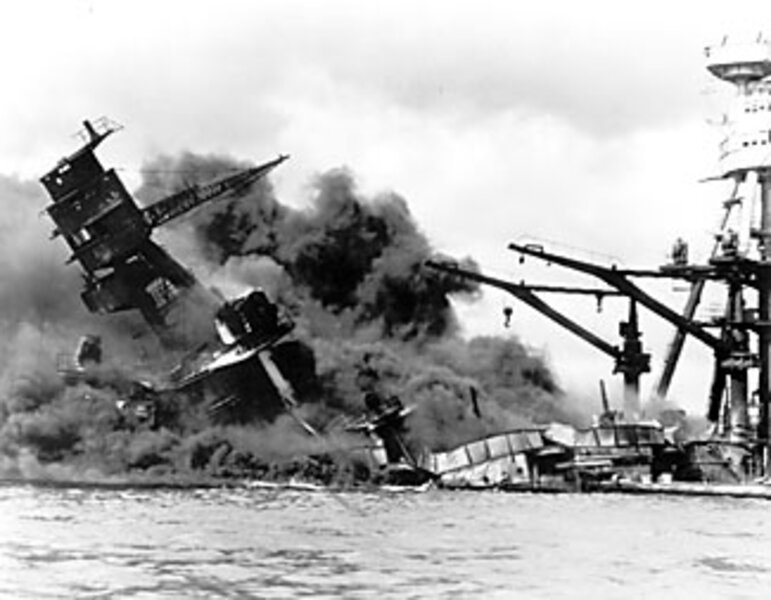Pearl Harbor attack: Who was really to blame?
Loading...
| Washington
Days after the Japanese attack on Pearl Harbor on December 7, 1941, Secretary of the Navy Frank Knox arrived in Hawaii. He'd been sent by President Roosevelt himself, with simple instructions: find out what happened, and how.
On December 16, Secretary Knox – a former journalist – issued a report that was full of vivid tales of US heroism to a still-grieving nation. He talked about the battleship captain who had refused to be evacuated from the burning bridge of his ship; the motor launch skipper who pulled those blown overboard from the flames of the burning harbor; and the mechanics who pulled machine guns from burning planes, and fired back.
Knox's secret report to FDR was more bracing. It counted up US losses and noted that US forces had been taken completely by surprise.
"Neither the Army nor the Navy Commandant in Oahu regarded an air attack on the Army air fields or the Navy Stations as at all likely," Knox wrote privately.
Investigations began immediately
In the aftermath of Pearl Harbor, investigations began immediately. In some ways, they continue today, as historians, journalists, and ordinary citizens debate the meaning and causes of what remains, despite September 11, the most shocking surprise attack in the nation's history.
Knox's trip was the first official probe. His public comments minimized the damage, so as not to give information away to the Japanese. His secret findings emphasized, among other things, the "meticulous detail" of the Japanese military's plans of attack, and "their courage, ability, and resourcefulness".
Knox's report caused FDR to order a commission, headed by Supreme Court Justice Owen Roberts, to carry out a more thorough look at the attack's circumstances.
The Roberts Commission report, issued in December, 1942, exonerated major political figures in Washington, and laid much of the blame for ill-preparedness on the top commanders on scene in Hawaii: Army General Walter Short and Admiral Husband Kimmel. Both were demoted, and both retired from the military within months.
Subsequent investigations began to spread blame for the debacle more widely. Six more probes were held during the war years, counting separate efforts from the Army and Navy, and associated spin-offs.
For instance, a Naval Board of Inquiry held in 1944 blamed Admiral Harold Stark, chief of naval operations at the time of Pearl Harbor, for not adequately advising Kimmel of the critical situation between the US and Japan in the weeks prior to the attack.
Wartime secrecy needed
All these investigations were hampered in some manner by the need to maintain wartime secrecy, particularly in regards to US code-breaking efforts.
At war's end the US Congress launched a final, thorough investigation of Pearl Harbor that included a review of all relevant classified documents, including translations of intercepted and decoded Japanese messages. This Joint Congressional Committee effort issued a 40-volume report in mid-1946.
Blame all around
In this report, blame for the disaster was laid at the feet of everyone from Secretary of War Henry Stimson to commanders on scene. A minority annex censured the behavior of President Roosevelt, as well.
In sum, the Congressional committee found that Washington-based officials failed to give proper notice to a series of intercepted messages from Tokyo to its consulate in Honolulu that indicated keen interest in the harbor berthing plan and other dispositions of the US fleet.
Nor did Washington react quickly enough to the "one o'clock message" – the last of a 14-part message series sent from Tokyo to Japanese diplomats in Washington – the congressional probe found. This message ordered the destruction of code books and indicated that hostilities of some sort would begin at 1 pm, Eastern Standard Time.
"If properly appreciated, this intelligence should have suggested a dispatch to all Pacific outpost commanders supplying this information," concluded the Joint Committee report.
In the decades since the war's end, family members and proponents of Gen. Short and Adm. Kimmel have pushed to overturn the general conclusion that the two on-scene commanders should shoulder the burden of the blame.
In 1999, the Senate passed a non-binding resolution exonerating both Kimmel and Short, and asking President Clinton to posthumously restore their ranks. Clinton did not respond. President Bush similarly declined to take such an action.
Revisionists blame FDR
Revisionists have long pushed the notion that a true examination of the evidence would show the FDR knew the attack was to occur and that he allowed it in order to rouse the nation for participation in the war.
For instance, the 1999 book "Day of Deceit", by Robert Stinnett, held that FDR's effort to provoke Japan into war was a principal policy of his administration throughout 1941. FDR must have known that war was imminent from intercepted messages, according to Stinnett. Nor did the Japanese fleet maintain strict radio silence as it steamed towards Hawaii.
But the mere existence of such information does not indicate that it was speedily understood and used, noted the New York Times in its 1999 review of Stinnett's book.
It may be disturbing in hindsight to see that commanders in Hawaii weren't told of all that was contained in the intercepted messages, but "that failure by itself does not prove Mr. Stinnett's contention of a conspiracy to deprive commanders of the information they needed," wrote reviewer Richard Bernstein.
See also:





